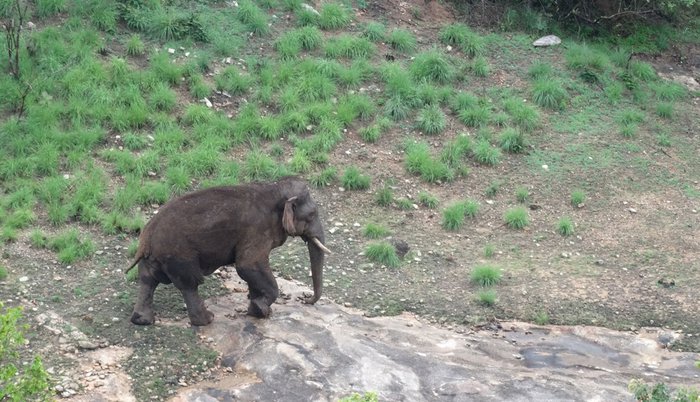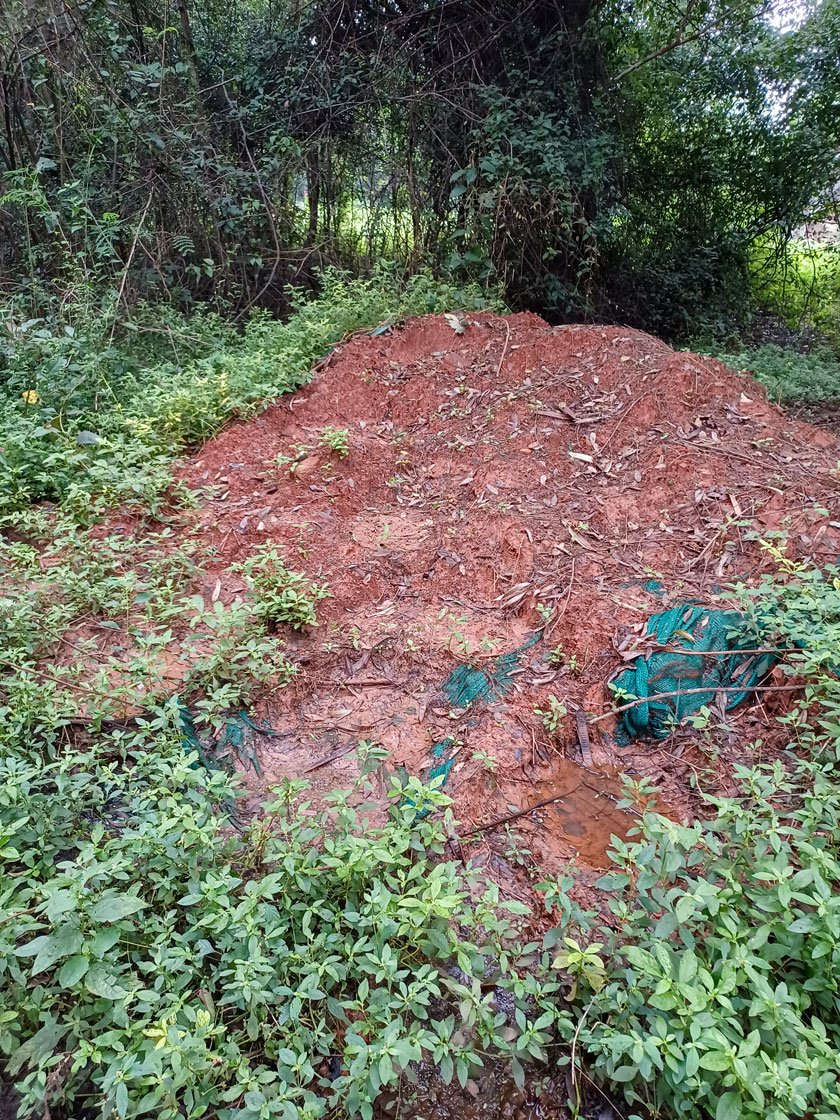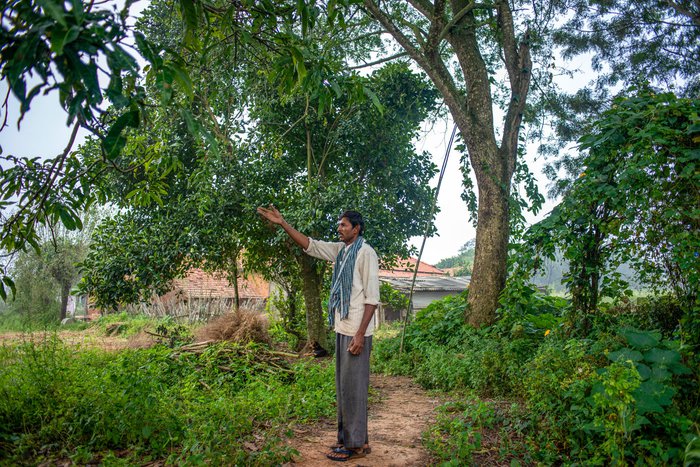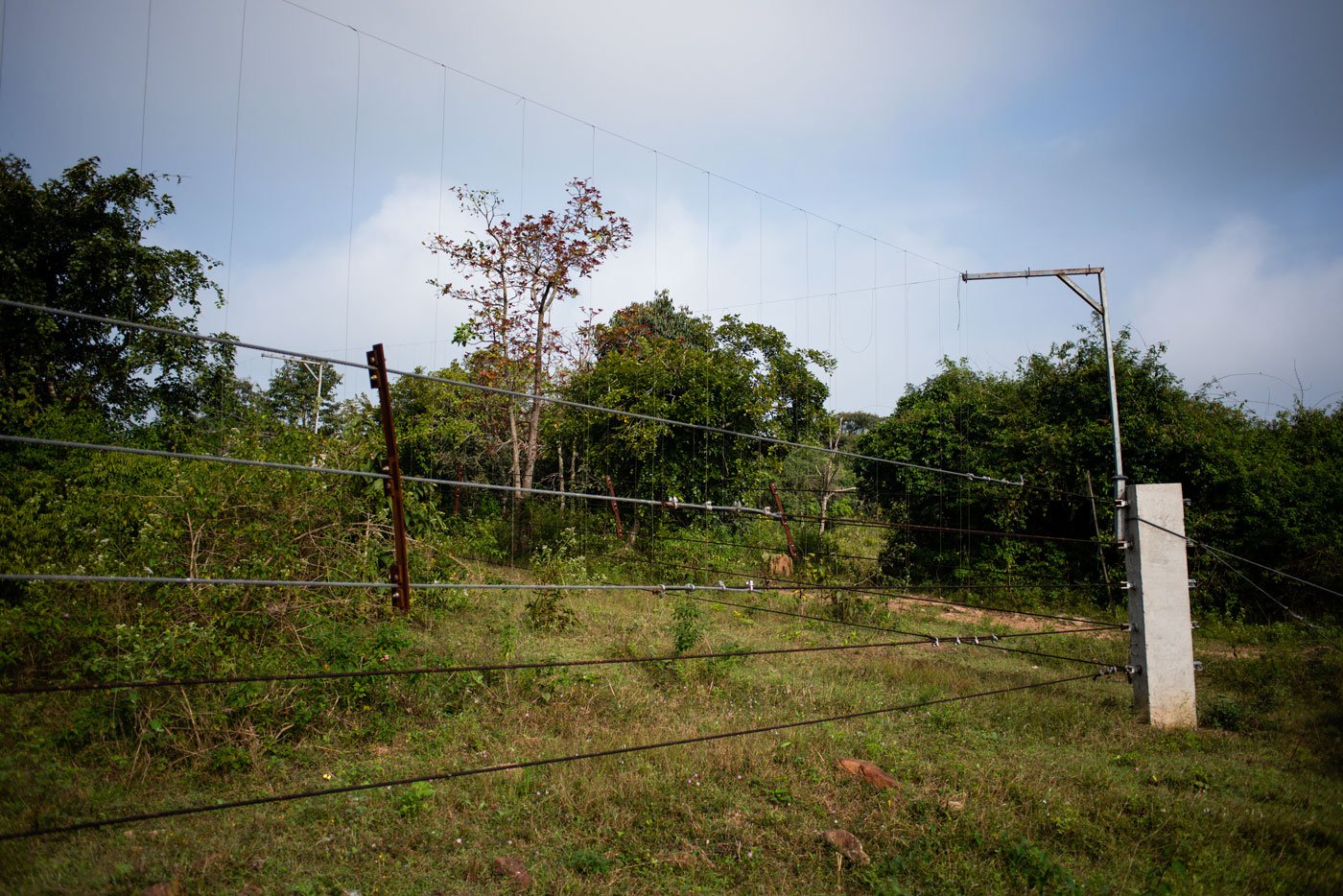We are walking around the hillocks and fields looking for jumbo footprints.
We find plenty that are larger than dinner plates, deep imprints on the soft earth. The older ones are gently crumbling. Others point to what that animal did: a little saunter, a good meal, a lot of dung. And a trail of things it chucked around: granite poles, wire fences, trees, gates…
We stop to photograph everything elephant. I send a picture of the footprints to my editor. “Was there an elephant attached to it?” he replies hopefully. I pray his hopes are dashed.
Because, from what I heard, in Krishnagiri district’s Ganganahalli hamlet, elephants are unlikely to bless your head and ask for a banana. That might be the routine with temple elephants. These are their wild cousins. And they are usually hungry.
My trip to meet the
ragi
farmers of Krishnagiri district, Tamil Nadu, in December 2021, led me, unexpectedly, down the elephant path. I thought there would be discussions around the economics of farming. Sure, there were some. But mostly, I heard, in farm after farm, that the reason they are growing just enough
ragi
(finger millet) for their homes is – elephants. Between poor prices (25 to 27 rupees a kilo, instead of the 35 to 37 that will help them break even), climate change, and the spectacularly heavy rains, farmers have it rough. Add the trunks and tusks of elephants, and it has been, very nearly, the mammoth straw that has broken the farmer’s back.
“Elephants have so much talent. They have learnt how to hold down the wire ropes and cross wire fences. They know to use trees to short-circuit electric fences,” explains Anandramu Reddy. “And they always look out for the herd.” Ananda – as he’s called – is a
farmer in Vadra Palayam
hamlet, in Denkanikottai
taluk
.
He
walks us to the edge of the Melagiri Reserve Forest. That’s part of the
Cauvery North Wildlife Sanctuary.


Left: The large footprint of an elephant. Right: Damage left behind by elephants raiding the fields for food in Krishnagiri district
For years, elephants have been wandering out of the forest and into the fields. Groups of pachyderms would descend on the villages, eating much of the ragi crop and trampling the rest. It pushed the farmers to think of alternatives – tomatoes, marigold, roses. Anything they believe has a market, and something the elephants don’t care to eat. “After the electric fence here came up in 2018-19, the herd doesn’t come out. But nothing,” he assures me, “stops the male elephants: Mottai Vaal, Makhana, Giri…their hunger drives them out and into our fields.”
“The quality of the forest is one of the main reasons for the human-elephant conflict,” explains S.R. Sanjeev Kumar, the honorary wildlife warden of Krishnagiri and Dharmapuri districts in Tamil Nadu. In Krishnagiri alone, he estimates, a whopping 330 villages are affected by this problem.
Over a zoom call, shortly after my visit to the region, Sanjeev Kumar – also the founding member and past president of Kenneth Anderson Nature Society (KANS), a wildlife conservation NGO – shares a presentation. The image on the screen is stunning, black with elephant-shaped dots. “Each one represents a village where conflict takes place. And this data has been taken from crop damage claims,” he says.
Elephants strike just after the northeast monsoon, when the crops are ready to be harvested. “There are also human deaths, 12 or 13 in a year [in Krishnagiri district], which are crowded between December and January. That is, usually, during the
ragi
harvest time.” Elephants also die. “There is retaliation. And accidents that happen on railway lines, highways, or when they fall into open wells. And they also get electrocuted by wires laid out for wild boars.”
Elephants eat over 100 species of plants, Sanjeev explains. “They eat many parts of the plant. Based on observation of captive elephants, we know that they eat 200 kilos of grass and drink 200 litres of water. “But,” he points out, “in the wild, the quantity varies greatly from season to season – so can their body condition.”

In this photo from 2019, Mottai Vaal is seen crossing the elephant fence while the younger Makhna watches from behind
Moreover, Lantana camara – an invasive, introduced species of flowering plant – now covers “85 to 90 per cent of the forest in the Hosur region”. It is a hardy plant, untouched by goats and cows, and quickly spreads. “It is the same in Bandipur and Nagarhole. The paths for safaris are cleared of lantana so that elephants will come there to eat the grass and can be sighted.”
Lantana, Sanjeev argues, is the prime reason elephants come out of their zone. Besides, for the jumbos,
ragi
is juicy and very tempting. “If I was one, I would come to eat it too.” Males, particularly, are under a compulsion to raid crops. For, between the ages of 25 and 35, they undergo a growth spurt. These are the ones who take big risks.
But not Mottai Vaal. He is an old fellow and knows his limits. Sanjeev reckons he is past 45, closer to 50. He calls him the ‘sweetest’ elephant. “I have seen a video when he is in musth .” ( Musth is a biological and hormonal growth-related condition in male elephants that is considered both normal and healthy. But it also means they can be more aggressive in the 2-3 months it lasts.) “Usually, they can be violent, but Mottai Vaal was so calm. He was in a herd with elephants of various ages, and he was quietly standing to one side. He has seen the world.”
Sanjeev pegs him to be about 9.5 feet tall, weighing perhaps 5 tonnes. “He has a sidekick, Makhana, and they also band together with other young males.” Would he have children, I ask. Sanjeev laughs. “He must have many.”
Why does he raid fields if he’s past the growth spurt? Sanjeev Kumar puts it down to Mottai Vaal needing to retain his body condition. “He gets very good food outside –
ragi
, jackfruit, mango – and after eating it, he goes back into the forest.” There are other male elephants who eat cabbage, beans, cauliflower. These are alien foods, grown with pesticides, Sanjeev says.
“Three years ago, it was very bad. Farmers who invested heavily in tomatoes and beans lost a lot of money. And while the elephant eats one part, it damages five times as much.” More and more farmers are switching to crops that won’t tempt the elephant. Mottai Vaal and his pals are effectively changing the agricultural practices in the area.

A rare photo of Mottai Vaal, in the Melagiri hills
For years, elephants have been wandering out of the forest and into the
fields. Groups of pachyderms would descend on the villages, eating much
of the
ragi
crop
*****
“Earlier, we got some compensation. Now, they [the authorities] take photos, but we don’t get any money.”
Vinodhamma, farmer from Ganganahalli hamlet in Gumlapuram village
Gopi Sankarasubramani is among the select few who have met Mottai Vaal really, really close. Early one morning, he opened the door of his cottage in Navadarshanam, a non-profit organisation half an hour’s drive from Gollapalli, where we are staying with our host, Gopakumar Menon.
Instead of the friend Gopi expected to see, there was the elephant, tall and wide – and shy. But then Mottai Vaal turned away, almost immediately. Sitting in the verandah of a beautiful house on the hillside, Gopi tells us many stories. Some are about
ragi
. The rest are about elephants.
An aerospace engineer by education, Gopi switched from technology to growing food. For years now, he has lived and worked on the 100 acres that the Navadarshanam Trust manages in Ganganahalli hamlet, in Gumlapuram village. The Trust relies on contributions from residents, visitors, and workshops, to sustain itself. “We don’t make big plans, we don’t have big budgets, we try to keep it simple and small.” One of the foremost activities is their food cooperative that involves nearby villagers. With small landholdings, and farming taking up just a few months of the year, they were forced to depend on the forest to survive.
“We provided 30 families, mostly from Ganganahalli village, with the space and know-how to make value-added food products, and weaned them off their culture of going to the forest,” says Gopi.
Ragi
is now primarily grown for their homes. And only the surplus is sold.
In the 12 years that Gopi has been in Navadarshanam, the significant change he’s seen is in the variety of
ragi
that is grown – from native to short duration hybrid, down from the usual 4-5 months to 3. It is far better, he says, when a dry land crop stays on the ground longer; “it accumulates more nutrition”. Obviously, the shorter duration one doesn’t. The result is, people end up eating two
muddes
[balls] of
ragi
instead of one. “It is that stark a difference.”


Left: Gopi Sankarasubramani at Navadarshanam's community farm in Ganganahalli hamlet of Gumlapuram village. Right: A damaged part of the farm
But the farmers anyway make a switch because a quicker crop needs to be guarded for less time. Plus, the market does not pay differently. “The farmers, moreover, have to synchronise the growing,” says Gopi. “If many are guarding – one shouting from this corner and another from that – there is a chance to keep the elephant at bay. If everybody else has harvested the shorter duration crop, the elephants will come for yours...”
Our conversation is punctuated with beautiful bird noises. There is whistling and laughing and singing, as if they, too, want to share news from the forests.
After a noon meal –
ragi
mudde
with spinach gravy – we are handed out crunchy groundnut candy and fragrant
ragi
laddus
. The women who made them – Vinodhamma and B. Manjula – speak in Kannada (which Gopi and his friends translate for me). Between rain and the elephants, they say, much of their
ragi
is gone.
They tell us that they eat
ragi
every day, and also feed it to their children – a porridge of “medium thickness” until they begin to eat rice when they’re older. They store the annual millet crop at home in sacks, and grind it as and when they need it. But this year, it was going to be difficult to stretch their poor harvest.
Both the women are from Ganganahalli hamlet around Navadarshanam, and are just back from lunch. In their fields – Vinodhamma has 4 acres and Manjula 1.5 – they grow
ragi
, paddy, legumes and mustard. “When there is unseasonal rain, the
ragi
seeds sprout in the plant itself,” Manjula says. And the crop is then spoilt.
To avoid this, Vinodhamma’s family decided to harvest quickly and use a machine to swiftly separate the
ragi
and the stalk. She makes neat rows in the air with her hands, and her actions bridge the gaps in language.
Their frustration about the human-animal conflict comes through even without translation. “Earlier, we got some compensation. Now, they [the authorities] take photos, but we don’t get any money.”


Left: Manjula (left) and Vinodhamma from Ganganahalli say they lose much of their
ragi
to unseasonal rain and elephants. Right: A rain-damaged
ragi
earhead
How much does an elephant eat? A lot, says Gopi. One time, he recalls, two elephants, over two nights, ate about 10 bags of ragi worth over 20,000 rupees. “One chap also ate 21 jackfruit in a single raid. And cabbages...”
Farmers lose sleep to save their harvest. Gopi recalls sitting on the
machan
, night after night, for two years during the
ragi
season, looking out for elephants. It's a tough life, he says, and by the morning, you’re beat. From the narrow and winding roads around Navadarshanam we spot many
machans
. Some are
pucca
, others are rough and ready. Most have a kind of bell – a tin can and a stick attached to a rope – a way to warn others that an elephant has been sighted.
The real tragedy is that often the elephant raids the crops anyway. “We couldn't even stop it when one showed up,” Gopi recalls. “We burst crackers, tried everything, but he did as he pleased.”
Ganganahalli region has a peculiar problem now: the forest department’s elephant fence ends very close to Navadarshanam, creating a gap that almost channels elephants into their land. And so, from 20 raids in a year, it’s almost every night when there’s a crop ripe for harvest.
“People on either side of the fence are getting hit. When you start [fencing in the elephants], you cannot stop.” Gopi wags a finger and shakes his head.


Left: A makeshift machan built atop a tree at Navadarshanam, to keep a lookout for elephants at night. Right: A bell-like contraption in the farm that can be rung from the machan ; it serves as an early warning system when elephants raid at night
*****
“My wife wants to see me more often.”
A 60-year-old farmer, bogged down in guarding crops from elephant raids, to a National Green Tribunal judge
The human-elephant conflict needs a sensitive and sustainable solution for many reasons. Firstly, the scale of the problem is as big as the elephant itself. Globally, says a paper in Frontiers in Ecology and Evolution , reviewing current management strategies: “Many of the world’s 1.2 billion people who live on less than $1.25 USD per day reside in Asian and African elephant range countries.” And these marginalised communities are forced to “increasingly compete with other species, like elephants, for space and resources."
In India, 22 states face encounters with elephants, says honorary wildlife warden Sanjeev Kumar, with major ones happening in Tamil Nadu, Karnataka, Kerala, Orissa, West Bengal, Chhattisgarh and Assam.
Official figures
submitted in Rajya Sabha, by Ministry of Environment, Forest and Climate Change, disclosed that in less than three years – April 2018 to December 2020 – 1,401 humans and 301 elephants died because of this.
On paper, there is every intention to compensate the farmer for her/his losses. A 2017 Government of India
document
issued by Ministry of Forests, Environment and Climate Change’s Project Elephant Division states that the recommended compensation should be 60 per cent of the estimated crop damage. And it adds, “If the compensation is close to 100 per cent of the crop value there will be no incentive for the farmer to protect his crops.”
K. Karthikeyani, Indian Forest Service (IFS) officer and Assistant Conservator of Forests at Office of the Wildlife Warden, Hosur, tells me that annually, more than 200 hectares of crops are damaged in the Hosur Forest Division. “The forest department gets between 800 to 1,000 applications from farmers seeking compensation for their crops. And the annual payout ranges between [Rs.] 80 lakhs to 1 crore,” she says. This includes the 5 lakhs paid for each human death – 13 people are killed every year by elephants in the region.


Left: Tusker footprints on wet earth. Right: Elephant damaged bamboo plants in Navadarshanam
“The maximum compensation payable for an acre is Rs. 25,000,” explains Karthikeyani. “Unfortunately, for a horticultural crop this is not enough, as farmers incur a loss of over 70,000 rupees per acre.”
Moreover, to claim compensation, the farmer has to submit the paperwork, get the field inspected by the agricultural or horticultural officer (as the case may be), then the village administration officer (VAO) has to inspect and certify their land documents, and finally, the forest range officer visits and takes pictures. The district forest officer (DFO) then sanctions the compensation, if any.
The downside is farmers have to wait – sometimes up to three agricultural cycles – to get 3,000 to 5,000 rupees as compensation. “It would be better if it was settled immediately, using a revolving fund,” says Karthikeyani.
Resolving this conflict will therefore not just save the lives of humans and the livelihoods of farmers, and improve their quality of life, it will also reclaim goodwill for the state forest department, Sanjeev Kumar points out. “Right now, the burden of elephant conservation is borne by agriculturalists,” he adds.
Guarding a crop from marauding elephants night after night, for months, is no fun, Sanjeev acknowledges. And it keeps farmers tied down too many hours and days. During a National Green Tribunal (NGT) meeting, he recalls a farmer telling the judge, ‘My wife wants to see me more often’. The farmer is over 60 years old, Sanjeev recalls, and his wife suspects him of having an affair.
The stress on the farmer translates into problems for the forest department. "They take it out on the department. They have broken the office. They have staged road
rokos
, abused and manhandled staff. This puts the forest department on the backfoot and interferes with the protection duties,” says Sanjeev Kumar.

Anandaramu Reddy explaining the elephants ’ path from the forest to his farm in Vadra Palayam hamlet
The human-elephant conflict has an economic cost, an environmental cost, and also a psychological one. Imagine running a business knowing it can be trashed or pulled down any day, for no fault of yours
And besides all of this, there is the threat to the lives of the elephants. It is a pressing and urgent one, given that a census conducted in 2017 puts the number of elephants in Tamil Nadu to be 2,761 . That’s just under 10 per cent of the Indian elephant population, which is 29,964 .
Retaliation, electrocution, road and rail accidents, all of them take away from this small genetic pool. At one level, it seems a problem without a solution. Except, Sanjeev and others did find one – with the help of Murthy…
*****
“Ideally, we do not want to depend on electricity at all. Solar is unreliable. Plus, elephants have figured out electricity.”
S.R. Sanjeev Kumar, honorary wildlife warden of Krishnagiri and Dharmapuri districts
The idea for the Melagiri Elephant Fence in Krishnagiri district came from Addo Elephant National Park in South Africa, says Sanjeev Kumar. “Raman Sukumar, ‘the elephant man of India’, told me about it. There they had used discarded railway lines and elevator cables. And once they put up the fence, the conflict ended.” Sanjeev followed up on the Addo Park idea.
Until then, there were many attempts in Hosur Forest Division to keep elephants inside the forest and out of the field – but none were successful. They had tried elephant-proof trenches, which are deep pits around the forest boundary. They tried conventional solar fences, spiked barriers, and even imported some thorny trees from Africa. Nothing worked.
It was when Deepak Bilgi, IFS, was posted as the Deputy Conservator of Forests of Hosur Division, that a breakthrough happened. Bilgi took an interest in the idea, found the money for it, spoke to the collector, and “we decided to do put up an experimental fence,” explains Sanjeev.

A section of the Melagiri Elephant Fence, which is made of pre-cast, steel-reinforced concrete posts, and steel wire rope strands
Interestingly, there is not much data on what the strength of an elephant is. Or what weight one or many can push. So they installed a prototype in Mudhumalai and tested it with kumkis (trained captive elephants). One of them – a five-tonne, tuskless chap called Murthy – was notorious for killing several people, until he was rehabilitated by the forest department. Ironically, it was his job, as beta tester, to check out the cables that would reduce human-elephant conflict.
“You can’t guess his past,” Sanjeev says, “because he was so well trained. He had become so docile and gentle.” Now, Murthy is retired – the retirement age of elephants, I am informed, is 55 – and enjoys a good life, including boarding and lodging, and is even an occasional ‘stud’, mating with female camp elephants. In the wild, his services would not be required – or allowed – as younger males would compete with him for that privilege.
From Murthy, they learnt that 1,800 kilogram is the maximum force that an elephant can produce under certain conditions. The first two kilometres of fence they built – designing the posts based on Murthy’s experience – was not far from Ananda’s house.
“We learnt a lot from that attempt. In just a week, Makhana – who hangs around with Mottai Vaal – broke it. We had to redesign it, and now it is 3.5 times stronger than the original design. The wire rope is already very strong, and can bear a load of 12 tonnes. That is, you can lift two elephants with that rope.”
Compared to other models, their fence, Sanjeev says, is nearly indestructible. It is made of pre-cast, steel-reinforced concrete posts, and steel wire rope strands. Elephants cannot break the post or wire. They may climb over or climb through. “This gives us a chance to find a specific solution to plug any problem areas. The team also camera-trapped our friends coming out or going back after raiding crops.” And based on what they saw, they made improvements. “Sometimes the elephant comes along and shows us why it needs more work,” Sanjeev laughs.
This non-electric steel fence costs Rs. 40 lakhs to 45 lakhs per kilometre. The district collector – with some private sector help – as well as that of state government’s Tamil Nadu Innovative Initiatives scheme, funded the first two kilometres and subsequent 10 kilometres of the fence.

Anandaramu walking along the elephant fence and describing how it works
Of the 25 kilometres that are now fenced, 15 are non-electric, and 10 are electrified (with solar power) elephant proof fencing. The voltage is high – 10,000 volts – and it is a small amount of direct current which pulsates every second. “Generally, the elephant will not die when they touch it,” explains Sanjeev. “The electrocutions happen from the 230V AC current that we use at homes or farms. Here they are protected because the current is only a few thousandths of that used in homes. Otherwise, it would kill them.”
When the DC voltage falls to 6,000 volts – if some tree or plant has fallen on the fence, for instance – the elephants walk across happily. And for some males, the urge to eat is so great, they simply plough through. “It's difficult to understand what’s going on in their minds,” Sanjeev admits.
“Ideally, we do not want to depend on electricity at all. Solar is unreliable,” he points out. Plus, elephants have figured out electricity. They know the concept of insulation and conductivity. They will take a branch or tree and short the fence. Or a male will use a tusk – which they have learnt is a bad conductor of electricity – to break it. “I have a photograph of an elephant testing the fence with a small branch to see if there is electricity,” Sanjeev laughs.
*****
“
Because of the Melagiri fence, elephants have moved to the south. This is a good thing, as there is continuous forest there, stretching all the way…onwards to the Nilgiris.
”
K. Karthikeyani, Indian Forest Service officer
The elephant conflict has an economic cost, an environmental/ecological cost, and also a psychological one. Imagine running a business knowing it can be trashed or pulled down any day, for no fault of yours. That’s the life of cultivators who have lived and farmed – for generations – in Krishnagiri district.
Besides feasting on the local produce, crop raiding elephants have learnt to move greater distances, and it has happened in the last decade and a half, explains Sanjeev Kumar. “From venturing a kilometre or two beyond the reserve forest, they now travel into Andhra and Karnataka, nearly 70 or 80 kilometres, spend a couple of months there, and come back.” In Hosur area, where a lot of crop raiding happens, the elephants are bulky; they look healthy and have many babies.
Young elephants take a lot of risk. Sanjeev collected data about elephant deaths outside reserve forests, and plotted them. He discovered that about 60 to 70 per cent of the deaths are of young male elephants.


Left: Mango plantation damaged by elephants in Anandaramu’s field. Right: Ananda with more photographs showing crops ruined by elephant raids
Ananda tells me they rarely see the herd these days. Just the boys: Mottai Vaal, Makhana and Giri. He still WhatsApp’s me images of elephant raids every now and then. There are fallen mango branches, crushed banana trees, trampled fruits, and heaps and heaps of elephant poo. When he speaks, he is resigned, never angry.
“That is because, if there is anger, it is directed towards the government or forest department,” says Sanjeev. “They know compensation is very late or does not come, so they have stopped claiming it. And that is a problem, because then the data won’t show the true intensity of the conflict.”
The only way to reduce the conflict is to keep the elephants inside the forest. The problem will go away only when their natural habitat is restored. “That is 80 per cent of the solution. Getting rid of lantana, that is also important.”
For now, in the 25 kilometres that is fenced – which is 25 per cent of the elephant-human interface boundary – the conflict has reduced by 95 per cent. “Because of the Melagiri fence,” says Karthikeyani, “elephants have moved to the south. This is a good thing, as there is continuous forest there, stretching all the way to Sathyamangalam and onwards to the Nilgiris. This is better for them.”
The Melagiri fence is a physical barrier for the most part. “Where it is electrified with solar power, it is a psychological barrier – it only gives them a small shock and makes them fear it. But elephants are smart. Beehive fences, or tiger roars, or alarm calls do not work.” Basically, Sanjeev Kumar says, you cannot fool all the elephants all the time.
But elephants always seem to be one step ahead. As if they’ve figured out, they were teaching people how to keep them inside, they started breaking the camera traps. As Sanjeev speaks, I stare at the picture on my screen: two elephants huddled together before the fence, plotting how to cross the ropes and reach the
ragi
…
The author would like to thank Gopakumar Menon for his help, hospitality and valuable inputs while reporting this story.
This research study is funded by Azim Premji University as part of its Research Funding Programme 2020.
Cover photo (Mottai Vaal): Nishant Srinivasaiah.




